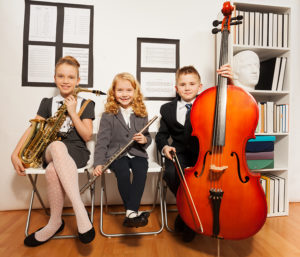The majority of our public and private schools have a music department, or at least some classes in music – instrumental, choral or general classroom music. The schools that have individuals performing or ensemble groups are eligible to enter local or regional music festivals that are not part of the regular school curriculum. It is up to the discretion of the music teacher whether they consider the festival experience worthwhile for their students.
The California Music Educators Association (CMEA) states, “The major purpose of the festival is to afford groups, their directors and individual students, an opportunity to listen to one another in an atmosphere of mutual involvement with the art of music. Every student and director should therefore make the attempt to do so.”
This is another important element that is an addition to the regular school classes and the teacher. It is a learning situation that is very different from their daily experience in the local classroom. One of the great advantages is the students hear other groups of the same age and grade level. 
The school may enter a festival by filling out an application form and sending in an entrance fee. All participating students must be enrolled in their respective school music programs. The festivals are usually held on Saturdays, with some starting on Friday and extending into the weekend. Festivals are divided into categories based on the type, size, and grade level of the performing groups.
Large Group Festivals
These include band, orchestra and choral. There can be an orchestra-only festival, but usually they are with the same festivals for bands. Three adjudicators, or judges, listen to each performance and either write or tape comments. The festival requires that art music, rather than pop music, be used in all festivals. There is no restriction regarding the difficulty of the music performed. However, the adjudicator may comment if the grade level of the music—too easy or too difficult—does not reflect the level of the group.
Sight-reading or a clinic regarding their performance is then held after the performances. Elementary, junior high/middle schools, and high school groups have the option to sight-read or have a clinic. Most high school groups elect to sight-read.
Solo & Ensemble Festivals
This is where either a soloist or small ensemble performs before one adjudicator for written or verbal comments. A small group is two or more parts with no doubling (one player per part) that play art music. All students in small ensembles must be from the same school. With the exception of a large percussion ensemble, no ensemble may be conducted by the director or anyone else. In this festival, the time limit from entry to exit is ten minutes. Some time should be left so the adjudicator can make comments on the performance.
Jazz Festivals
These groups have at least nine players with a minimum of three woodwinds, three brass, and a rhythm section. There are rules and regulations regarding soloists and improvisation. Jazz combos are encouraged to stay within a total time of 20 minutes, including comments after their performance.
Adjudication and the Adjudicator
This process is an integral part of the whole festival experience. It is meant to be helpful, instructive, and positive. The purpose is to help the  students achieve a better concept of how to improve their ensemble or solo performance.
students achieve a better concept of how to improve their ensemble or solo performance.
Adjudicators are chosen from CMEA members who have demonstrated their expertise and musical skills consistently over a number of years. The adjudicator is considered to be a master teacher and a person who is knowledgeable in the field of their expertise.
A good adjudicator listens for tone, intonation, blend, balance, precision, articulation, dynamics, rhythm, and interpretation. That is a lot to take in while writing comments as the music is played. After the performance, if there is time, they meet with the group and verbally explain what he has heard, makes comments on how to improve, and leaves with a positive statement on the group and the performance. Above all, the verbal comments must be consistent with the written comments and the eventual rating. The importance of listening carefully by the students cannot be exaggerated. Listening is the key to fine ensemble playing.
The ratings that the adjudicator awards are in five categories: Superior or outstanding, excellent or above average, good or average, fair or below average and needs improvement. The needs improvement rating is rarely given for a number of reasons. Usually groups at this level do not participate in these festivals as it means a lack of preparation and musical understanding. Judges must use caution when assigning this rating. Strong comments regarding how bad a group played would be very discouraging and demeaning. Sarcastic comments should never be used. One must exercise tact when commenting on a performance, if there is anything that could be considered positive, it should be emphasized. The students should go away with something rather than total defeat. Comments on how to improve should be helpful.
Having been an adjudicator for large groups and solo and ensemble festivals for many years, I have seen and experienced the joy and heartache of successful and below average student musicians.
An important consideration is groups always have the option to ask for comments only and not receive a rating. This option relieves a lot of anxiety and embarrassment for the group and the director.
These festivals are a great learning tool for school groups. They hear other groups and learn from people who are not their teacher. They get a different viewpoint from the one they hear every day. Not only do students learn but the teacher can also learn new and perhaps different ways of teaching and directing. Hopefully the experience is a win-win situation for all concerned.
Please submit your questions and comments to banddirector01@comcast.net
Visit our website at www.danvilleband.org for up-to-date information about the Danville Community Band.
Leave a Reply